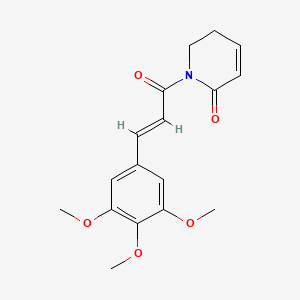Ferroptosis-centered Drug Response Information
General Information of the Drug (ID: ferrodrug0212)
| Name |
Piperlongumine
|
||||
|---|---|---|---|---|---|
| Synonyms |
Piperlongumine; Piplartine; 20069-09-4; UNII-SGD66V4SVJ; (E)-1-(3-(3,4,5-trimethoxyphenyl)acryloyl)-5,6-dihydropyridin-2(1H)-one; SGD66V4SVJ; PPLGM; CHEBI:8241; 1-[(2E)-3-(3,4,5-trimethoxyphenyl)prop-2-enoyl]-1,2,5,6-tetrahydropyridin-2-one; 1-[(E)-3-(3,4,5-trimethoxyphenyl)prop-2-enoyl]-2,3-dihydropyridin-6-one; 2(1H)-Pyridinone, 5,6-dihydro-1-(1-oxo-3-(3,4,5-trimethoxyphenyl)-2-propenyl)-, (E)-; 2(1H)-Pyridinone, 5,6-dihydro-1-[(2E)-1-oxo-3-(3,4,5-trimethoxyphenyl)-2-propen-1-yl]-; BRD2293; BRD-2293; (E)-1-[3-(3,4,5-Trimethoxyphenyl)acryloyl]-5,6-dihydropyridin-2(1H)-one; Piplartine;PPLGM; Prestwick_399; MFCD00075706; FERROUSFLUOBORATE; ST079382; Prestwick2_000604; Prestwick3_000604; Piperlongumine; Piplartine; PIPERLONGUMINE [MI]; 5,6-Dihydro-1-[(2E)-1-oxo-3-(3,4,5-trimethoxyphenyl)-2-propen-1-yl]-2(1H)-pyridinone; BSPBio_000508; PIPERLONGUMINE [INCI]; MLS002153903; SCHEMBL173092; SPECTRUM1505135; BPBio1_000560; CHEMBL465843; SCHEMBL2465593; 1-[3-(3,4,5-Trimethoxy-phenyl)-acryloyl]-5,6-dihydro-1H-pyridin-2-one; ACon1_001541; CHEBI:92424; DTXSID801029762; HMS1569J10; HMS2096J10; HMS2234K24; Piperlongumine, >=97% (HPLC); BCP13030; EX-A2925; HY-N2329; BDBM50462013; NSC794671; s7551; AKOS024284776; CCG-214375; NSC-794671; NCGC00096028-01; NCGC00096028-02; NCGC00096028-03; NCGC00096028-04; NCGC00096028-14; AC-32683; AS-74140; BP-25401; SMR001233252; CS-0021113; P2361; A14124; EN300-7424497; A920539; SR-01000841248; A1-00162; J-012992; N-(3,4,5-Trimethoxycinnamoyl)-D3-piperidin-2-one; Q7197361; SR-01000841248-2; BRD-K24132293-001-05-3; BRD-K24132293-001-09-5; BRD-K24132293-001-16-0; 5,6-Dihydro-1-(3,4,5-trimethoxycinnamoyl)-2(1H)-pyridinone; 1-[(2E)-3-(3,4,5-Trimethoxyphenyl)-2-propenoyl]-5,6-dihydro-2(1H)-pyridinone; 1-[(2E)-3-(3,4,5-Trimethoxyphenyl)-2-propenoyl]-5,6-dihydro-2(1H)-pyridinone #; 1-[(2E)-3-(3,4,5-trimethoxyphenyl)prop-2-enoyl]-5,6-dihydropyridin-2(1H)-one; 5,6-Dihydro-1-[1-oxo-3-(3,4,5-trimethoxyphenyl)-2-propenyl]-2(1H)-pyridinone, 9CI; 5,6-dihydro-1-[1-oxo-3-(3,4,5-triMethoxyphenyl)-allyl]-2(1H)-pyridinone; 5,6-Dihydro-1-[1-oxo-3-(3,4,5-trimethoxyphenyl)-trans-2-propenyl]-2(1H)-pyridinone; Prop-2-en-1-one, 3-(3,4,5-trimethoxyphenyl)-1-(2,3-dihydropyridin-6(1H)-one-1-yl)-; 2(1H)-PYRIDINONE, 5,6-DIHYDRO-1-(1-OXO-3-(3,4,5-TRIMETHOXYPHENYL)-2- PROPENYL)-, (E)-
Click to Show/Hide
|
||||
| Structure |
 |
||||
| Formula |
C17H19NO5
|
||||
| IUPAC Name |
1-[(E)-3-(3,4,5-trimethoxyphenyl)prop-2-enoyl]-2,3-dihydropyridin-6-one
|
||||
| Canonical SMILES |
COC1=CC(=CC(=C1OC)OC)C=CC(=O)N2CCC=CC2=O
|
||||
| InChI |
InChI=1S/C17H19NO5/c1-21-13-10-12(11-14(22-2)17(13)23-3)7-8-16(20)18-9-5-4-6-15(18)19/h4,6-8,10-11H,5,9H2,1-3H3/b8-7+
|
||||
| InChIKey |
VABYUUZNAVQNPG-BQYQJAHWSA-N
|
||||
| PubChem CID | |||||
Full List of Ferroptosis Target Related to This Drug
Unspecific Target
| In total 1 item(s) under this Target | ||||
| Experiment 1 Reporting the Ferroptosis-centered Drug Act on This Target | [1] | |||
| Responsed Disease | Breast cancer | ICD-11: 2C60 | ||
| Pathway Response | Fatty acid metabolism | hsa01212 | ||
| Ferroptosis | hsa04216 | |||
| Cell Process | Cell ferroptosis | |||
| In Vitro Model | MIA PaCa-2 cells | Pancreatic ductal adenocarcinoma | Homo sapiens | CVCL_0428 |
| PANC-1 cells | Pancreatic ductal adenocarcinoma | Homo sapiens | CVCL_0480 | |
| CFPAC-1 cells | Pancreatic ductal adenocarcinoma | Homo sapiens | CVCL_1119 | |
| BxPC-3 cells | Pancreatic ductal adenocarcinoma | Homo sapiens | CVCL_0186 | |
| Response regulation | Piperlongumine (PL) is a natural product with cytotoxic properties restricted to cancer cells by significantly increasing intracellular reactive oxygen species (ROS) levels. The study demonstrated that PL induced cancer cell death through, at least in part, the induction of ferroptosis. And the triple combined treatment with PL, CNA and SSZ is highly effective against pancreatic cancer. | |||
